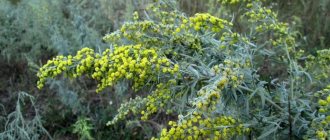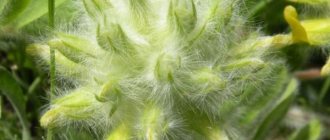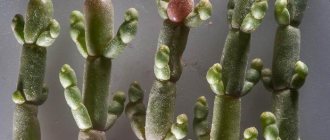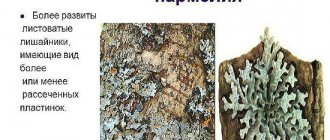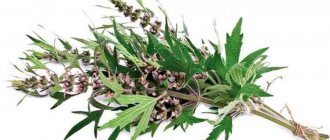Description of the plant. Appearance and distribution area
Tansy grass is a common weed that grows near roads, fields, shrubs, meadow steppes, forests and dry meadows. It is quite difficult to find dense thickets of grass, but it grows in forest and forest-steppe zones.
As a representative of the group of perennials, tansy grows up to 1.5 m in height and has a pair of shoots. They have a grooved surface and are bare. In rare cases, they are pubescent with a slight woodiness. The upper elements branch.
The foliage is alternate, emitting a strong aroma when rubbed. The leaves are dark green at the top and grayish-green at the bottom.
Baskets of golden-yellow flowers are collected at the tops of the shoots, forming lush inflorescences. Each floral element is tubular. Tansy fruits are seeds.
photo of a flowering plant in its natural habitat
The flowering period begins in June and lasts until September. Young flowers are harvested in early to mid-summer, and ripe fruits are collected in the fall. Each part of the herb is characterized by a camphor aroma, since it contains essential oils. The plant is also rich in tannins. Knowing what tansy looks like for weight loss or fighting gastrointestinal diseases, it can be easily distinguished from other weeds.
Several thousand years ago, the inhabitants of Ancient Egypt, Persia and Greece used an extract of the herb to embalm corpses. Based on its roots, it was possible to obtain green paint, as well as fight fleas or flies.
For many years, the grass served as a food plant for sika deer, sheep, ground squirrels and marmots.
nature has endowed the plant with a rich chemical composition and a lot of beneficial properties for the body
Chemical composition. Medicinal and beneficial properties
Tansy, the beneficial properties and contraindications of which have been studied for centuries, has been recognized not only by traditional medicine, but also by official medicine. In the second case, it is considered as a powerful choleretic or anthelmintic.
Due to its wide distribution and availability, the grass can be harvested and used for its intended purpose independently. Flowers are harvested at the end of July, when the active flowering stage begins, away from highways and large populated areas.
When cutting flowers, it is necessary to cut the stem up to 40 mm long. Then the prepared raw materials need to be hung under a canopy and scattered in a thin layer on paper.
Adherents of traditional medicine use the inflorescences as a remedy for worms. Homemade decoctions can quickly expel roundworms and pinworms, and sometimes tapeworms.
Tansy infusion has a choleretic effect for liver diseases, gastrointestinal spasms, gastritis and ulcers. A decoction based on flowers promotes good secretion and separation of bile, normalizing acid balance and appetite.
With the help of herbs you can fight constipation and hemorrhoids. Due to its diuretic effect, dried tansy is used to combat urolithiasis or inflammatory processes in the kidneys.
In the presence of festering wounds, ulcers and boils, compresses are used. Decoctions work well against swelling and pain. To combat the manifestations of rheumatism, an herb infused with dessert wine is used. It is often used to make tablets for the liver, for the health of the female genital organs and for the body.
To obtain high-quality medicinal raw materials, certain rules must be followed when preparing
Collection and preparation
To determine when to collect a medicinal herb, you need to find out where tansy grows and when it blooms. Flowering begins in June and lasts until mid-September. Depending on the growing environment, the specifics of assembly and harvesting are determined, and the chemical composition of the plant also changes. Thus, mountain grass has a higher concentration of essential oils.
Medicinal herbs can only be harvested in areas remote from highways and large cities. Raw materials must be fresh and not damaged by pests. Collection is carried out in the morning after the dew has evaporated from the greenery or before sunset in dry weather.
Tansy should be dried in air in shaded conditions. Some owners cover it with a canopy or use special drying equipment. When using dryers, it is important to avoid excessive heating of the air. The optimal temperature is no more than 40°C.
Properly prepared raw materials help in the treatment and prevention of various diseases
Useful properties of tansy
The flowers of the plant contain proteins, carbohydrates, glycosides, alkaloids, bitterness, organic acids, tannins, carotene, rutin, vitamin C, minerals, flavonoids, and essential oils.
The toxic and poisonous properties of tansy are known, but in therapeutic doses, decoctions from the flowers of the plant have a choleretic, diaphoretic, anti-inflammatory, antispasmodic, tonic, antitumor effect, tone the muscles of the gastrointestinal tract, increase the production of gastric juice, increase the amplitude of heart contractions, slow down its rhythm, and increase blood pressure.
It is known that tansy helps against worms: roundworms and pinworms, and heals gastrointestinal ulcers. Preparations based on it can be taken for liver diseases, constipation, flatulence, stomach colic, gastritis with low acidity, enterocolitis, nervous disorders, epilepsy, migraines, inflammation of the kidneys, and bladder.
Treatment with tansy is prescribed for gout, rheumatism, pulmonary tuberculosis, colds and fever, malaria, furunculosis,
Tansy essential oil has a local irritant effect and stimulates the central nervous system.
Indications for the treatment of tansy diseases
The beneficial properties of tansy allow it to be used for a variety of purposes.
Gastrointestinal diseases
The herb is used in the presence of diseases of the gastrointestinal tract, such as gastritis and ulcers. It restores the tone of the intestinal muscles, promotes the effective separation of bile and fights low acidity. Other indications for use include:
- Inflammatory processes in the mucous membranes of the colon.
- Hepatitis.
- Pancreatic diseases.
- Infectious problems affecting the gastrointestinal tract.
- Problems with microflora.
- Intense gas formation.
- Constipation.
Having a calming and tonic effect, tansy tea fights muscle spasms and has an anthelmintic effect. To combat gastrointestinal diseases, you can combine the leaves with olive oil.
Weed-based products improve the functionality of the digestive system and improve appetite. To make tansy treatment as effective as possible, you should use the following instructions for use:
- Take 1 tbsp. l. dried flowers and 400 ml of water.
- Pour the raw material with water and cook for 5 minutes.
- Wait until the tea is well infused and filter it.
- Take 100 ml 3 times a day.
for the preparation of medicinal products, you can use pharmaceutical raw materials or independently prepared
Nervous exhaustion
When considering tansy herb, medicinal properties and contraindications, it is necessary to take into account its benefits for the nervous system. The plant is indicated for the following disorders:
- Severe pain in the brain area.
- Sleep problems.
- Epilepsy.
- Hysteria.
- Hypochondria.
To prepare the solution, you need to pour 100 g of dry grass with 400 ml of vodka and leave for 3 days. The finished tincture is taken 30 drops 3 times a day before meals.
Female cycle disorders
Tansy has been used in gynecology for quite a long time. This is due to its benefits for women with menstrual irregularities and other gynecological diseases. To prepare an effective remedy for this problem, you will need to take a container and add 1 tbsp. l. dried flowers, pour 400 ml of boiling water over them and move them to a warm place for half an hour. After infusion of the decoction, it should be taken 0.5 cups three times a day. The procedure is repeated for 2-5 days.
pharmaceutical dry raw materials are used to prepare medicinal infusions and decoctions that help in the treatment of skin pathologies
Skin diseases
Tansy flowers, which are sold in pharmacies, are an effective remedy for skin diseases. They can be used for:
- Psoriasis.
- Scabies.
- Damage to the skin that does not go away over time.
- Ulcers and eczema on the skin.
- Mechanical damage.
In folk medicine, for the listed problems, the following compress is used:
- A tablespoon of herb is placed in a glass and poured with boiling water.
- After this, take a bandage, which is moistened in the tincture and applied to the damaged skin.
To increase the effectiveness of the product, use baths with this tincture.
Blue tansy oil helps fight various skin diseases. To prepare, you will need to prepare fresh inflorescences and grind them until the juice forms. The resulting consistency is diluted in 200 ml of vegetable oil and cooked for 30 minutes over low heat. The finished product is rubbed into the affected areas of the skin.
Joint inflammation
Tansy is able to fight joint inflammation, salt deposits and severe joint pain. To make an infusion, you need to pour a glass of boiling water over a tablespoon of flowers and place it in a cool, dark place. After filtering, take the product one tablespoon 4 times a day.
You can also make an effective weed-based bath. To do this, you will need to purchase horsetail, weed grass, string, elderberry, currant leaves and stinging nettle from the pharmacy. Next you should mix 5 tbsp. l. strings, 4 tansy and horsetail, 3 elderberries and 2 nettles. After this, 100 g of the composition is poured into a liter of water and put on fire until it boils. The finished solution is brought to a boil and poured into the bath.
The procedure is repeated every day for 15 days.
Seborrhea
The problem of seborrhea leads to the appearance of dandruff in the hair. To get rid of it, you will need to make a decoction for rinsing. To do this, pour half a glass of grass and 3 liters of water into a saucepan. The broth is boiled over a fire for 10 minutes and then placed in a dark place to infuse.
the herb supports women's health and promotes successful conception
Infertility
Tansy tincture is highly effective for infertility. To prepare the herbal mixture, you need to take 100 g of veronica, 50 g of herbs, 75 g of rosemary. The mixture is added to a cooking container and poured with 3 cups of boiling water. After overnight infusion, drink 1 glass 3 times a day before meals.
Types and varieties of tansy with photos and names
Gardeners cultivate not only common tansy, but also other species:
Silver tansy (Tanacetum argenteum)
This garden plant is an ornamental foliage plant. Its leaf blades are pinnate and erect. Some experts classify this species as belonging to the genus Yarrow.
Balsam tansy (Tanacetum balsamita), or canuper, or kalufer
This plant is cultivated throughout almost the entire territory of Eurasia. It is edible and spicy-aromatic. Some experts attribute this species to the genus Chrysanthemum.
Tansy (Tanacetum corymbosum), or Caucasian chamomile
This species, distinguished by its unpretentiousness, is quite popular among gardeners. Outwardly, it looks like a disheveled chamomile.
Tansy (Tanacetum densum)
This low-growing species is distinguished by its high decorativeness and unpretentiousness. The pinnate leaf blades are silver in color. Loose baskets are colored yellow. This species has many varieties and varieties.
Tansy (Tanacetum parthenium), or feverfew
This decorative species is also quite popular among gardeners. This herbaceous plant is a perennial. Fragrant corymbose inflorescences are white in color.
Tansy Haradjanii (Tanacetum haradjanii)
The birthplace of this plant, which is highly decorative, is Syria. Low, dense, lush bushes are decorated with silver-gray leaves, as well as short-petalled yellow daisies.
Tansy (Tanacetum macrophyllum)
This popular species is native to southeastern Europe and Turkey. The lush corymbs have a whitish color, and in appearance they are similar to yarrow flowers, but tansy has larger foliage and the entire bush.
Tansy (Tanacetum ptarmiciflorum)
This garden plant is very popular among gardeners. It comes from the Canary Islands, and was previously classified as a member of the Chrysanthemum genus. This shrub is a perennial. Its leaf blades and shoots are velvety because there is fine pubescence on their surface. The flowers have a whitish color and an irritating aroma. There are a large number of varieties that differ from each other in the size and color of the leaf blades.
Precautions when taking
Since tansy contains toxic substances, before using it for treatment, you need to familiarize yourself with possible contraindications and side effects. It is important to take into account the optimal dosage, age characteristics and condition of the patient. In childhood and old age, the dose is reduced.
In this case, therapy cannot last more than 7 days, with the exception of rare cases when the course is extended to 2-3 weeks. With prolonged consumption of the herb, mental disorders may occur, so it is better to take 2 courses of 1 week per year.
Due to its powerful choleretic effect, the herb is contraindicated for people with stones in the bile ducts. It is not recommended to use tansy during pregnancy and breastfeeding.
The weed can cause premature contractions of the uterus and have an abortifacient effect.
Effect on the body
The plant has a positive effect not only for the female body, but also for men. However, before that you need to determine how to prepare and use it. Males can take the drug to combat heart, liver and kidney diseases. The flower is also used to eliminate the manifestations of gout and hemorrhoids.
Side effects and contraindications
Tansy contains some toxic substances (ketone and thujone), which cause a number of side effects and contraindications if the dosage is not observed. To prevent complications, it is worth considering the following features:
- Do not consume large amounts of herbal medicines, as this can lead to poisoning. The permissible daily intake is 0.5 liters.
- It is better for children and pregnant women not to take the composition. When carrying a child, the drug may have an abortifacient effect.
Other contraindications include diseases of the cardiovascular system. In case of overdose, vision impairment, problems with the kidneys and nervous system, depression and even death may occur.
during the infusion process, all beneficial substances pass into the drink and have a positive effect on the functioning of all organs
Composition of tansy and medicinal properties
The rich composition of tansy (tannins, alkaloids, essential oils, tanacetin bitterness, organic acids) determines its therapeutic capabilities. Chamomile flowers are included in herbal preparations used for many diseases, both acute and chronic. Scientists have identified a high percentage of steroids and flavonoids in the composition. In particular, the Yakut Research Institute isolated steroid compounds in tansy that have choleretic, antispasmodic and antiparasitic properties.
The presence of plant glycosides in the plant explains the vasodilating effect of tansy, which is used in the complex treatment of angina pectoris.
Decoctions and infusions of tansy flowers are rich in flavonoids - free radical inhibitors with antioxidant capabilities. They are taken orally for gastrointestinal problems.
Anti-inflammatory activity and effects on the immune system were studied by a group of scientists (Igor Shepetkin, Mark Quinn and Hans Sö). They provided evidence of the antitumor capabilities of tansy.
Thanks to acacetin, the plant has antihypertensive properties that are not inferior to the popular medicine for hypertension, papaverine.
Today, tansy is being studied as a source of tanacetans. Polysaccharides of this group are present in flowers. They belong to the class of pectins, which have astringent properties. Tanacetanes are able to neutralize the harmful effects of “bad” cholesterol.
The instructions for medications containing tansy, which describe its medicinal properties and uses, also mention the toxic effects of the flowers. The poison ketone thujone, identified in their composition, in large doses provokes serious intoxication of the body. There are known cases of poisoning of livestock, so it is so important to follow the instructions and dosage.
The use of tansy flowers in the form of decoctions, infusions and tinctures
Tansy treatment of the liver, kidneys, gastrointestinal tract, skin, etc. is carried out using various means based on this medicinal herb. In most cases, water and alcohol extracts are practiced, including decoctions, alcohol tinctures and infusions.
If decoctions are used, it is important to choose the right dosage, since the herb contains toxic substances.
The aqueous extract is taken both internally and externally to combat skin diseases. A popular extract recipe involves using 5 g of yellow baskets, which are brewed with boiling water and infused for 3 hours. The product is taken in 1 tbsp. l. before eating. This recipe is effective for hepatitis, acute gastrointestinal disorders, gastritis and other diseases.
alcohol infusion is a powerful remedy that has an antiseptic effect
Alcohol tinctures have found their use in dentistry because they eliminate the problem of stomatitis. To create the product, you need to dilute a spoonful of the product in a cup of warm water and use the composition to rinse the mouth.
Tansy recipes against parasites
Tansy is a highly effective remedy against various parasites, including pinworms. To prepare an enema to combat these organisms, you need to prepare the following components:
- Seeds - 1 tbsp. l.
- Garlic - 2 cloves.
- Milk - 0.5 l.
The milk needs to be heated and the seeds ground into powder. You should also finely chop the garlic and combine all the ingredients. The liquid is cooled and filtered, and then injected into the anus.
tansy products have an antiparasitic effect and are used in the form of enemas and for oral administration
To get rid of Giardia, you can prepare 20 g of inflorescences, pour boiling water over them and boil for 1 hour. The drink should be consumed 0.5 cups before meals 3 times a day.
To combat roundworms, inflorescences are poured with boiling water and infused for 4 hours. After filtering, the product is taken 1 tbsp. l. 4 times a day.
When fighting bovine tapeworms, tapeworms or other tapeworms, a folk remedy called “Russian triad” is used. It consists of tansy, wormwood and cloves.
Tansy for prevention
Due to its special composition, the plant can be used as a powerful prophylactic against helminths. In order to prevent the appearance of parasites, it is necessary to drink a herbal drink 1-2 times a day 30 minutes before meals in the morning and evening.
Application in cosmetology
Possessing cleansing properties, tansy is actively used for cosmetic purposes. It effectively fights skin rashes, boils and pimples, providing an antiseptic effect.
If boils appear on the face, this may indicate the need for deep cleansing of the body, since the liver cannot cope with its functions. As a result of such phenomena, the skin becomes covered with painful rashes and loses its attractive appearance.
Tansy decoction allows you to get rid of many skin problems and prevent their occurrence in the future. The plant is also used as a hair balm, helping to reduce oiliness and add shine.

